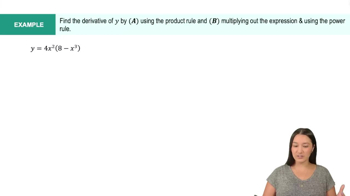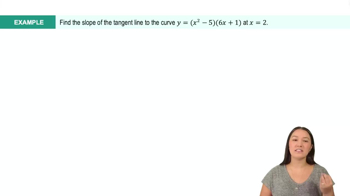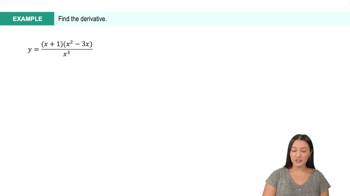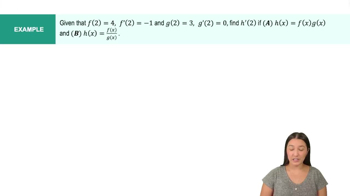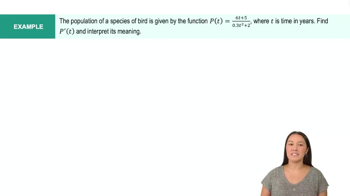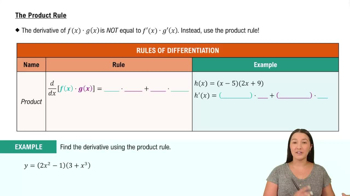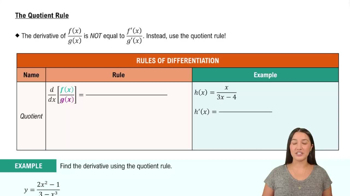Table of contents
- 0. Functions7h 52m
- Introduction to Functions16m
- Piecewise Functions10m
- Properties of Functions9m
- Common Functions1h 8m
- Transformations5m
- Combining Functions27m
- Exponent rules32m
- Exponential Functions28m
- Logarithmic Functions24m
- Properties of Logarithms34m
- Exponential & Logarithmic Equations35m
- Introduction to Trigonometric Functions38m
- Graphs of Trigonometric Functions44m
- Trigonometric Identities47m
- Inverse Trigonometric Functions48m
- 1. Limits and Continuity2h 2m
- 2. Intro to Derivatives1h 33m
- 3. Techniques of Differentiation3h 18m
- 4. Applications of Derivatives2h 38m
- 5. Graphical Applications of Derivatives6h 2m
- 6. Derivatives of Inverse, Exponential, & Logarithmic Functions2h 37m
- 7. Antiderivatives & Indefinite Integrals1h 26m
3. Techniques of Differentiation
Product and Quotient Rules
Problem 31
Textbook Question
Find and simplify the derivative of the following functions.
h(x) = (x − 1)(x3+ x2 + x+1)
 Verified step by step guidance
Verified step by step guidance1
Step 1: Identify the function h(x) = (x - 1)(x^3 + x^2 + x + 1). This is a product of two functions, so we will use the product rule to find the derivative.
Step 2: Recall the product rule for derivatives: if u(x) and v(x) are functions, then the derivative of their product is given by (uv)' = u'v + uv'.
Step 3: Let u(x) = x - 1 and v(x) = x^3 + x^2 + x + 1. First, find the derivative of u(x), which is u'(x) = 1.
Step 4: Next, find the derivative of v(x). Differentiate each term separately: v'(x) = 3x^2 + 2x + 1.
Step 5: Apply the product rule: h'(x) = u'(x)v(x) + u(x)v'(x). Substitute the derivatives and original functions: h'(x) = (1)(x^3 + x^2 + x + 1) + (x - 1)(3x^2 + 2x + 1). Simplify the expression to find the derivative.
Recommended similar problem, with video answer:
 Verified Solution
Verified SolutionThis video solution was recommended by our tutors as helpful for the problem above
Video duration:
4mPlay a video:
Was this helpful?
Related Videos
Related Practice



